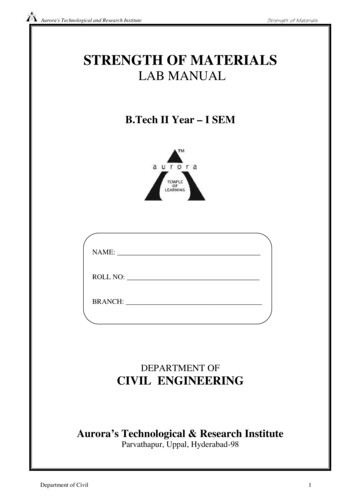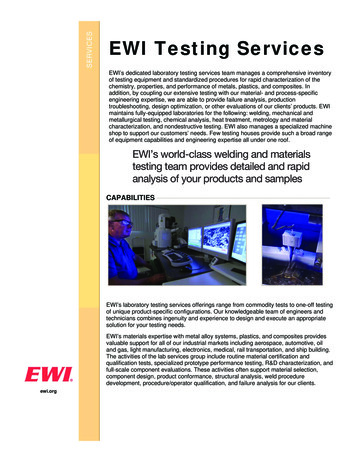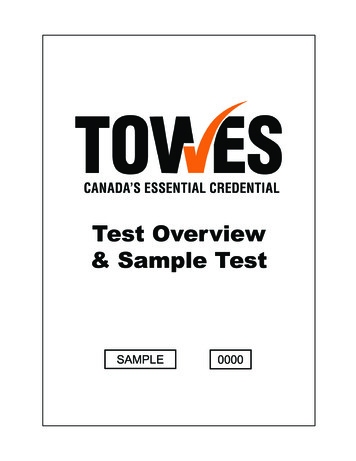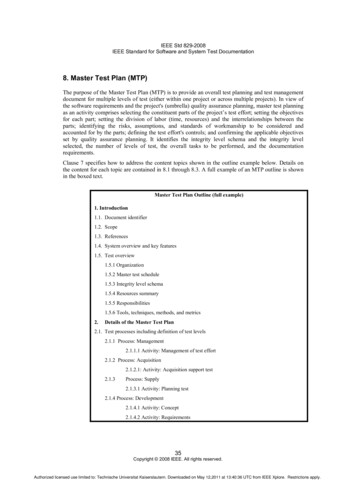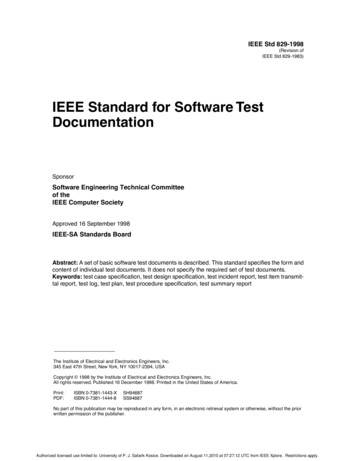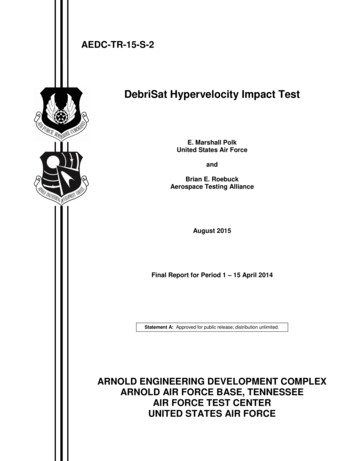
Transcription
AEDC-TR-15-S-2DebriSat Hypervelocity Impact TestE. Marshall PolkUnited States Air ForceandBrian E. RoebuckAerospace Testing AllianceAugust 2015Final Report for Period 1 – 15 April 2014Statement A: Approved for public release; distribution unlimited.ARNOLD ENGINEERING DEVELOPMENT COMPLEXARNOLD AIR FORCE BASE, TENNESSEEAIR FORCE TEST CENTERUNITED STATES AIR FORCE
NOTICESWhen US Government drawings, specifications, or other data are used for any purpose otherthan a definitely related Government procurement operation, the Government thereby incursno responsibility nor any obligation whatsoever, and the fact that the Government may haveformulated, furnished, or in any way supplied the said drawings, specifications, or other data,is not to be regarded by implication or otherwise, as in any manner licensing the holder orany other person or corporation, or conveying any rights or permission to manufacture, use,or sell any patented invention that may in any way be related thereto.Qualified users may obtain copies of this report from the Defense Technical InformationCenter.References to named commercial products in this report are not to be considered in anysense as an endorsement of the product by the United States Air Force or the Government.This report has been reviewed by the AEDC Office of Public Affairs (PA)and is releasable to the National Technical Information Service (NTIS). AtNTIS it will be available to the general public, including foreign nations.APPROVAL STATEMENTPrepared by:E. MARSHALL POLKUnited States Air ForceReviewed by:RICK RUSHINGTest ManagerApproved by:HULAND C. SMITHTechnical DirectorSpace & Missiles Combined Test ForceBRIAN E. ROEBUCKAerospace Testing Alliance
Form ApprovedOMB No. 0704-0188REPORT DOCUMENTATION PAGEThe public reporting burden for this collection of information is estimated to average 1 hour per response, including the time for reviewing instructions, searching existing data sources, gathering and maintaining the dataneeded, and completing and reviewing the collection of information. Send comments regarding this burden estimate or any othe r aspect of this collection of information, including suggestions for reducing the burden, toDepartment of Defense, Washington Headquarters Services, Directorate for Information Operations and Reports (0704-0188), 1215 Jefferson Davis Highway, Suite 1204, Arlington, VA 22202-4302. Respondents shouldbe aware that notwithstanding any other provision of law, no person shall be subject to any penalty for failing to comply with a collection of information if it does not display a currently valid OMB control number.PLEASE DO NOT RETURN YOUR FORM TO THE ABOVE ADDRESS1. REPORT DATE (DD-MM-YYYY)2. REPORT TYPExx-08-2015Final Report4. TITLE AND SUBTITLE3. DATES COVERED (From-To)1 – 15 April 20145a. CONTRACT NUMBERDebriSat Hypervelocity Impact TestDASG60-00-C-00725b. GRANT NUMBER5c. PROGRAM ELEMENT NUMBER6. AUTHOR(S)5d. PROJECT NUMBERPolk, E. MarshallUnited States Air ForceandRoebuck, Brian E.Aerospace Testing Alliance000138475e. TASK NUMBER5f. WORK UNIT NUMBER7. PERFORMING ORGANIZATION NAME(S) AND ADDRESS(ES)8. PERFORMING ORGANIZATION REPORTNO.Arnold Engineering Development Complex (AEDC)AEDC-TR-15-S-29. SPONSORING/MONITORING AGENCY NAME(S) AND ADDRESS(ES)10. SPONSOR/MONITOR’S ACRONYM(S)NASA Orbital Debris Program OfficeAttn: Dr. J.C. Liou2101 NASA ParkwayHouston, TX 7705811. SPONSOR/MONITOR’S REPORTNUMBER(S)12. DISTRIBUTION/AVAILABILITY STATEMENTStatement A: Approved for public release; distribution unlimited.13. SUPPLEMENTARY NOTESAvailable in the Defense Technical Information Center (DTIC).14. ABSTRACTThe space environment presents many hazards for satellites and spacecraft. One of the major hazards is hypervelocityimpacts from uncontrolled, man-made space debris. Arnold Engineering Development Complex (AEDC), the NationalAeronautics and Space Administration (NASA), the United States Air Force Space and Missile Systems Center (SMC),the University of Florida, and The Aerospace Corporation configured a large ballistic range to perform a series ofhypervelocity destructive impact tests in order to better understand the effects of space collisions. The test utilizedAEDC’s Range G light gas launcher, which is capable of firing projectiles up to 7 km/sec. A nonfunctional, full-scalerepresentation of a modern satellite called the DebriSat was destroyed in the enclosed range environment. Severalmodifications to the range facility were made to ensure quality data were obtained from the impact events. The facilitymodifications were intended to provide a high-impact energy-to-target-mass ratio ( 200 J/g), a nondamaging method ofdebris collection, and an instrumentation suite capable of providing information on the physics of the entire impact event.15. Subject TermsOrbital debris; light gas gun; AEDC Range G; hypervelocity impact; Iridium 33; Kosmos-2251, Debrisat, high-speedvideo, Low Earth Orbit Collision Testing, Fengyun-1C weather satellite, soft catch, debris recovery, Arnold EngineeringDevelopment Complex16. SECURITY CLASSIFICATION OF:A. REPORTB. ABSTRACTC. THIS PAGE17. LIMITATION OFABSTRACT18. NUMBEROF PAGES19A. NAME OF RESPONSIBLE PERSONMarshall Polk19B. TELEPHONE NUMBER (Include area code)UnclassifiedUnclassifiedStandard Form 298 (Rev. 8/98)Prescribed by ANSI Std. 739.18UnclassifiedSAR23(931) 454-5965
This page is intentionally left blank.
AEDC-TR-15-S-2PREFACEThe work reported herein was conducted by the Arnold Engineering Development Complex(AEDC), Air Force Test Center (AFTC), at the request of the Dr. J. C. Liou for the NASAJohnson Space Center (JSC), Houston, TX. Testing was conducted in Range G of the Spaceand Missiles Combined Test Force (CTF) from 1 to 15 April 2014 under AEDC Project Number13847.Statement A: Approved by publicrelease; distribution unlimited.i
This page is intentionally left blank.
AEDC-TR-15-S-2CONTENTSPage1.02.0INTRODUCTION . 31.1General . 31.2Previous Orbital Debrist Testing at AEDC . 3METHODS, ASSUMPTIONS, AND PROCEDURES . 42.1Test Objectives . 42.2Test Facility. 52.3System Under Test . 52.43.05.02.3.15x Scale Multishock Shield . 62.3.2DebrisLV . 72.3.4DebriSat . 8Test Planning . 102.4.1Launcher Configuration . 102.4.3Projectile Design . 112.4.4Target and Soft Catch Installation . 122.4.5Hazard Mitigation . 14RESULTS AND DISCUSSION . 143.1Launcher . 143.2Projectile . 143.3Debris Collection System . 153.4Instrumentation . 16SUMMARY . 19REFERENCES . 20FIGURESFigure1.SOCIT Installed in Range G Tank with Foam Paneling . 42.Shock Shield Installed in Range G Tank . 63.DebrisLV Assembly . 74.DebriSat Top View (Looking from Zenith to Nadir) . 95.DebriSat Component Layout. 96.Projectile Acceleration Profile .107.DebriSat Projectile Assembly .11Statement A: Approved by publicrelease; distribution unlimited.1
AEDC-TR-15-S-28.Soft Catch Partial Construction .129.Front Soft Catch Opening .1310. X-Ray of DebriSat Projectile Base Separation .1511. Posttest Softcatch.1612. DebriSat Impact Flash Sequence (Phantom 7.1 – f /16 – ND 3.0) .1713. DebrisLV Impact Flash Sequence (Phantom v711 – f/11 - Unfiltered) .18TABLESTable1.DebriSat Component Characteristics . 82.Measured Projectile Velocity and Mass .143.Phantom Camera Settings .17APPENDICESAppendixA. Test Instrumentation . 21B. Soft Catch Foam Configuration . 23Statement A: Approved by publicrelease; distribution unlimited.2
AEDC-TR-15-S-21.01.1INTRODUCTIONGENERALThe goal of the NASA DebriSat Program is to update space breakup models using data fromfragments generated by a hypervelocity collision involving a modern satellite in low Earth orbit(LEO). The breakup models currently used by DoD and NASA before the DebriSat Programwere partially based on the 1992 Satellite Orbital Debris Characterization Impact Test (SOCIT)project in the AEDC Range G facility (Ref. 1). This previous test project impacted targets thatwere representative of 1960s-era satellite technology. Collisions involving modern satellitessuch as Iridium 33 and Fengyun-1C indicated discrepancies between model predictions and theobserved data. The DebriSat Program was thus created to resolve these discrepancies. Themain component of the test project was the DebriSat system under test (SUT), an engineeredmodel of a modern, 60-cm/50-kg class LEO satellite. Through a high-energy hypervelocityimpact, the satellite would be catastrophically fragmented with all substantial particles beingcollected for further analysis. Characterization of the breakup fragments down to 2 mm in sizewould later be performed from the collected debris. The obtained data would include fragmentsize, area-to-mass ratio, density, shape, material composition, optical properties, and radarcross-section distributions. These data would then be used to supplement the satellite breakupmodels to better describe the fragmentation outcome of a modern satellite.1.2PREVIOUS ORBITAL DEBRIST TESTING AT AEDCThe SOCIT project provided key data to the DoD and NASA satellite breakup models for onorbit collisions. During this project AEDC performed high-energy impact tests using a solarpanel, an inter-stage adapter, and a complete surplus flight-ready Navy transit navigationsatellite. All of the hardware was surplus material that had been fabricated in the 1960s. Thesatellite itself was 46 cm diameter by 30 cm high and weighed 34.5 kg. The 63.5-mm-diamlauncher in Range G was used to fire a 150 g solid aluminum sphere into the satellite at 6.1km/sec providing 78 J/g impact energy-to-target-mass ratio (Ref. 2).The SOCIT project was mutually beneficial to DoD, NASA, and AEDC. DoD and NASAobtained data for their breakup model, and AEDC acquired important information about debriscollection materials and how they could be used in future testing. These debris collectionsystems are often referred to as “soft catch” due to their ability to capture debris particles withminimal changes to the initial impacting shape. SOCIT chose to use polyurethane foam withdensities of 60 kg/m3, 96 kg/m3, and 192 kg/m3. Boards of the foam were cut and attached torigid plywood backing that was then affixed to the inside of the range tank. The foam wasconfigured in multiple layers so that the first layers were low density, either 60 kg/m3 or 96kg/m3, and the final layers were constructed of the 192 kg/m 3 foam. This dual-density designreduced overall penetration depth and reduced debris deformation. Slow debris was capturedin the initial layers of low-density foam, and debris traveling at high velocity was captured in thelayers of dense foam (Ref. 3).Statement A: Approved by publicrelease; distribution unlimited.3
AEDC-TR-15-S-2Figure 1. SOCIT Installed in Range G Tank with Foam PanelingThe SOCIT project also helped determine a standard suite of instrumentation that should befielded for high-energy orbital debris test projects. Standard facility photography equipment(laser lit still cameras and high-speed video cameras) is not always capable of providing insightinto the actual impact occurrence due to impact flash and a lingering plasma/gas cloud.Instead, high-power x-rays systems are recommended to evaluate the debris field immediatelyafter impact. Other instruments such as radiometers and high-speed multispectral analyzershave been useful to provide information about impact flash and the constituents of thegas/plasma cloud.2.02.1METHODS, ASSUMPTIONS, AND PROCEDURESTEST OBJECTIVESThe main objectives presented to AEDC at the beginning of the NASA DebriSat Program was toprovide the maximum possible impact energy into the SUT based on the launcher capability andto also provide a collection system capable of capturing 90% of the debris fragments. AEDCand NASA jointly developed a facility configuration based on the operating envelope of thelauncher and AEDC experience with debris collection systems. General requirements were asfollows:Statement A: Approved by publicrelease; distribution unlimited.4
AEDC-TR-15-S-22.2 Targets: Scaled Multishock Shield, DebrisLV, and DebriSat 500-600 g hollow aluminum and nylon projectile 7 km/sec ( 0.1 km/sec) projectile velocity Test chamber pressure less than 267 Pa (2 torr) Soft catch system based on low-density foam material to collect resulting impact debris Record target impact data though AEDC facility high-speed instrumentationTEST FACILITYThe Range G launcher is a two-stage, light gas gun that is capable of launching various types ofprojectiles at velocities up to 7 km/sec. The facility routinely launches projectiles at velocitiesbetween 3-6 km/sec. Projectiles up to 203 mm (8.0 in.) diameter are launched into a 3-m (10ft)-diameter, 283.5-m (930-ft)-long instrumented tank that can be maintained at pressures from0.2 torr to 1.7 atmospheres. The launcher started test operations in 1962 as a 63.5-mm (2.5-in.)bore diameter but has been significantly upgraded over the years to launch larger masses athigh velocities with lower peak acceleration loads. Currently the facility has three sizes ofinterchangeable barrels: 84 mm (3.3 in.), 102 mm (4 in.), and 203 mm (8 in.).Range G is a unique light gas launcher not only because of its size, but also because of itsability to minimize acceleration loads (g’s). In 1994 the launcher was upgraded to the currentbarrel and pump tube configuration. This upgrade increased the light gas pumping capabilityand reduced peak acceleration loads by using a larger diameter pump tube and lengthening thebarrel. This launch upgrade gave AEDC the capability to accelerate projectiles with complexgeometries that would have often failed in the earlier 63.5-mm launcher configuration.2.3SYSTEM UNDER TESTThe test team chose to perform three impact experiments of which two utilized the soft catchdebris collection system. The first test was a checkout shot funded by AEDC to verify that the7.0 km/sec ( 0.1 km/sec) impact velocity could be attained with the Range G launcher. Thistest utilized a NASA-supplied 5x scaled version of a multishock shield constructed by theHypervelocity Impact Technology (HVIT) Group at NASA Johnson Space Center. No soft catchwas used on the validation shot. The second test was a full facility checkout shot using a lowcost target called DebrisLV. This SUT was a 15-kg representation of the upper stage from alaunch vehicle that was fabricated by the Aerospace Corporation. The third and final test wasthe critical data shot that utilized the DebriSat satellite. The DebriSat was a 56-kg full-scalereplica of a modern day LEO satellite with solar panels and multilayer insulation. DebriSat’sinternal components were structurally similar to real flight hardware but were nonfunctional.Statement A: Approved by publicrelease; distribution unlimited.5
AEDC-TR-15-S-22.3.15x Scale Multishock ShieldThe first target, a 5x scale multishock shield from NASA, was a piggyback target added to thecheckout shot to obtain additional hypervelocity impact data. The test article was a 5x scaledup version of a multi-shock shield (Fig. 2) which consisted of five separate bumpers. Fourbumpers were fiberglass construction and one was steel mesh. Two sheets of Kevlar fabricwere placed after each bumper. The overall length of the test article was 2.65 m. NASA testeda similar configuration using only the four fiberglass bumpers for an inflatable module projectseveral years prior to the Debrisat Program. The previous test used a 1.4-cm-diam sphericalaluminum projectile fired from a smaller light gas gun. To handle the larger DebriSat projectile,NASA ran ANSYS AUTODYN Hydrocode simulations of the impact event to determine whatstrengthening was required. This analysis indicated that the additional layer of steel mesh wouldbe required to fragment the cylindrical projectile design (Ref. 4). The recovered posttestassembly revealed that the NASA analysis was correct. The projectile fragmented early in theimpact sequence, and the final bumper had no penetrations.Figure 2. Shock Shield Installed in Range G TankStatement A: Approved by publicrelease; distribution unlimited.6
AEDC-TR-15-S-22.3.2DebrisLVThe second target, shown in Fig. 3, was a 17.6-kg structure intended to emulate common upperstage construction in LEO. The intent of this impact test was to obtain data to better understandfailure modes during hypervelocity impact fragmentation. The assembly consisted of a deepdrawn, welded 5154 aluminum tank with a 3.2-mm wall thickness. Realistic material dimensionsand attachment methods (rivets, adhesive bonding) were used on DebrisLV where the sixlongerons (aluminum, stainless steel, copper) were bonded to the tank and also where a 6061aluminum skin was riveted to the longerons. Two 6061 aluminum strap-on tanks were thenadded to the aluminum skin. An additional flight-qualified, thin-walled titanium tank and rollcontrol thruster (RCT) assembly was attached to the base of the aluminum tank. Four accessports were distributed at 90 deg around the perimeter of the tank, with three of the four portscovered with riveted access plates.Figure 3. DebrisLV AssemblyThe DebrisLV was fastened to mounts on the range tank ceiling and floor with six screw-linksand lengths of steel-braided cable. The SUT was hung at approximately 45 deg inclination inrelation to the gun line. The DebrisLV tank and the RCT subassembly were both pressurized inorder to simulate residual propellants contained in on-orbit vehicles. The titanium RCTcontained 6.3L helium gas at 50 psia, and the tank contained 44L xenon gas at 30 psia.Statement A: Approved by publicrelease; distribution unlimited.7
AEDC-TR-15-S-22.3.4DebriSatThe DebriSat satellite was engineered to emulate the components, subsystems, materials, andconstruction techniques of a modern LEO satellite. DebriSat is a hexagonal body containingseven compartmentalized bays. The nadir and zenith panels along with the vertical strutsconnecting them are constructed from anodized AL 6061-T6. Panels A-F and the structural ribsbetween the bays are constructed of composite sandwich structures with an AL 5052honeycomb core and M55J carbon fiber face sheets. The basic system characteristics of theDebriSat are given in Table 1. A detailed overview of the DebriSat structural layout is shown inFigs. 4 and 5.Table 1. DebriSat Component CharacteristicsItemSpacecraft MassDescription50 kgMain Body Size60 cm (Dia) 50 cm (H)Physical Envelope84 cm (L) 61 cm (W) 68 cm (H) (including extended components)DeployablesYes; one solar panel deployedPropulsionThermal ControlYes; AL COPV tank pressurized to 267 Pa (2 torr) with nitrogen toemulate end-of-lifeYes; all plumbing but no working fluidBatteryYes; inert lithium-ion battery packs (i.e., no electrolyte)AvionicsYes; all hardware (harnesses and processing boards), but no softwareMaterialsAL 6061-T6, AL 5052, AL 3003, aluminum purity: 99.9% , SS (316,304), copper, germanium, glass (solar cells), NBK7 glass, titanium,sapphire, T1000 fiber, M55J carbon fiber, PVE film (sheet, wire),kevlar, HDPE, polyurethane plastic, mylar sheets, polyimide film,kapton tape, and epoxies (CV10-2568, CV2960, CV2289, EC2216)Statement A: Approved by publicrelease; distribution unlimited.8
AEDC-TR-15-S-2Figure 4. DebriSat Top View (Looking from Zenith to Nadir)Figure 5. DebriSat Component LayoutDebriSat was also designed with safety considerations in mind since several personnel wouldbe exposed to the debris fragments. The satellite contained no beryllium parts and utilized inertlithium-ion batteries (no electrolyte) to minimize exposure to hazardous materials during posttesthandling.Statement A: Approved by publicrelease; distribution unlimited.9
AEDC-TR-15-S-2DebriSat used stainless-steel eye bolts on the circumference of the zenith and nadir panelswhich were then hooked into braided stainless-steel cables for hanging in the test tank. Screwlinks attached the cables to mounts on the floor and ceiling of the tank as well as to the eye boltmount points on the DebriSat itself.2.4TEST PLANNINGBased on the test requirements, the test project required a substantial planning effort to providea good method for conducting the three test entries in the Range G test facility. Multiple publicand private organizations involved in the effort made regular communications via phoneconferences and site visits. This approach ultimately allowed the team to create detailed plansand methods resulting in a maximization of data obtained with minimal risk. Due to the uniquenature of this test, the AEDC range personnel experience was key to guiding program personnelthrough the process of test design. The overall planning and support role of AEDC helped blendthe expertise of each group into a single team that was able to meet several different objectives.2.4.1Launcher ConfigurationThe Range G launcher was configured with 39.6 m of 84-mm-diam launch tube to reach the 7km/sec velocity requirement. This velocity is the upper limit of the Range G operating curve andrequired minimization of the projectile mass and a careful selection of the gun configuration.Prior to the DebriSat Program, AEDC had launched projectiles weighing 450 gm at 6.94 km/sec.An analysis was performed on the previous gun configuration, and a new operating cycle wasselected based on a preliminary projectile weight of 500-600 gm. A very high acceleration loadwas imposed on the projectile to reach the 7 km/sec target velocity. Peak instantaneousacceleration was just under 87,000 g’s, which is 20,000-50,000 g’s greater than the typicalAEDC 3-6 km/sec launch cycle.Instantaneous ,00015,0000510152025Travel Distance (m)Figure 6. Projectile Acceleration ProfileStatement A: Approved by publicrelease; distribution unlimited.10303540
AEDC-TR-15-S-22.4.3Projectile DesignThe projectile was based on a successful design from a previous AEDC hypervelocity impactproject. The design (Fig. 7) used a hollow aluminum cylinder made of 7075-T651 aluminumwith a nylon sleeve. During assembly the aluminum cylinder is coated with a light layer of roomtemperature vulcanization (RTV) silicone to prevent gas intrusion and then threaded into thenylon sleeve. The nylon sleeve provides a soft interface to the launcher bore and maintains aseal to prevent gun gas leakage around the projectile. An aluminum cap is threaded into thefront of the sleeve to provide a flat face for impact. Unlike the sphere and sabot projectiledesign as used in the SOCIT test series, this configuration allows the entire launch packagemass and resultant kinetic energy to be transferred into the target.Figure 7. DebriSat Projectile AssemblyThe previous design of this projectile was a 1,000-g version that was successfully launched atvelocities ranging from 4 to 6 km/sec. The lower launch velocity allowed this projectile to bedesigned with a significant margin of safety. It easily survived the mechanical loads imposed bythe gun launch. Compromising the strength in order to reach the 400- to 500-gm weightreduction required for the DebriSat Program was a major concern for the designers. Allstructural changes were analyzed in the ABAQUS explicit finite-element analysis (FEA) softwareusing input load conditions from the AEDC light gas gun simulation program. The computersimulation results indicated that weight could be reduced by increasing the outside and insidediameter of the aluminum insert, which effectively enlarged the internal void. The total length ofthe assembly could also be shortened without encountering stability problems both in the gunbore and in free flight.Statement A: Approved by publicrelease; distribution unlimited.11
AEDC-TR-15-S-22.4.4Target and Soft Catch InstallationAfter the SOCIT Program, AEDC continued to perform studies to evaluate different materialscapable of capturing high-velocity fragmentation particles. Experiments with a wide variety ofmaterials showed that good data could be obtained with low-cost bundles of ceiling tile, but thelayered foam of varying density used on SOCIT was the best solution to collect small and largedebris particles at varying velocities. The foam design was a more costly option, but it wasselected for the DebriSat project since fidelity of the captured debris was a programrequirement. Only two significant changes were made to the foam design between the SOCITProgram and the DebriSat Program.The first change was a new octagonal system (Fig. 8) that was developed for the 10-ft insidediameter AEDC range tank. This geometry allows more spacing between the impact point andthe front face of the foam panels, reduces foam damage from the impact blast wave, allows thedebris cloud to expand slightly further, and reduces the mass that impacts a single piece offoam. The octagon shape was configured to provide a nearly equidistant path from the testarticle to provide a better characterization of the debris field.Figure 8. Soft Catch Partial ConstructionThe second change was a modification to the foam density gradient. The DebriSat foam softcatch panel design used an improved density gradient by adding more low-density outer layersand using three differing foam densities per panel instead of just two. The AEDC studies afterthe SOCIT Program showed that a mixture of low-density and high-density foam was not idealStatement A: Approved by publicrelease; distribution unlimited.12
AEDC-TR-15-S-2for high-speed debris fragments. The low-density foam often did not reduce the speed of thedebris sufficiently, and in turn the debris would penetrate the remaining layers of high-densityfoam and impact the rigid plywood backing. Increasing the density of the outer layer to slow thelarger debris would in turn deform some of the smaller pieces of debris. The three-layerapproach added the capability to capture high-speed debris while still retaining the benefits ofthe low-density outer layer. The three densities of foam were 48 kg/m3, 96 kg/m3, and 193kg/m3. The foam was Last-A-Foam FR-3700 Performance Core Series from General Plastics.The foam boards were all precut to 2 x 4 ft., carefully stacked in the density gradient, and boundto plywood backing using nylon banding straps. Simple strapping was favored over adhesivesbecause it would be very easy to separate the layers for analysis after the test. After strapping,each panel’s front, rear, and individual layers were marked with a unique ID code. Down-rangepanels, expected to absorb the most debris, were twice the thickness of the side and up-rangepanels, with much more low-density material. The foam was also color coded to assist indetermining the loca
DebriSat Hypervelocity Impact Test E. Marshall Polk United States Air Force and Brian E. Roebuck Aerospace Testing Alliance August 2015 Final Report for Period 1 - 15 April 2014 Statement A: Approved for public release; distribution unlimited. ARNOLD ENGINEERING DEVELOPMENT COMPLEX ARNOLD AIR FORCE BASE, TENNESSEE AIR FORCE TEST CENTER
